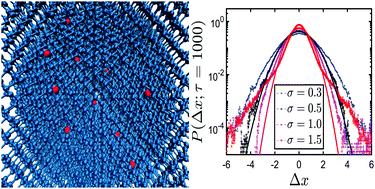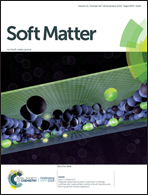Transport of probe particles in a polymer network: effects of probe size, network rigidity and probe–polymer interaction†
Abstract
Fundamental understanding of the effect of microscopic parameters on the dynamics of probe particles in different complex environments has wide implications. Examples include diffusion of proteins in biological hydrogels, porous media, polymer matrix, etc. Here, we use extensive molecular dynamics simulations to investigate the dynamics of the probe particle in a polymer network on a diamond lattice, which provides substantial crowding to mimic the cellular environment. Our simulations show that the dynamics of the probe increasingly becomes restricted, non-Gaussian and subdiffusive on increasing the network rigidity, binding affinity and probe size. In addition, the velocity autocorrelation functions show negative dips owing to the viscoelasticity and caging due to the surrounding network. These observations go with the general experimental findings. Importantly, for a probe particle of size comparable to the mesh size, unrestricted motion engulfing large length scales has been observed. This happens with a more flexible polymer network, which is easily pushed by the bigger probe. On increasing the rigidity of the network, the bigger probe can not efficiently push the network and as a result the long tail disappears. Our study gives a general qualitative picture of the transport of probes in a gel-like medium, as encountered in different contexts.



 Please wait while we load your content...
Please wait while we load your content...